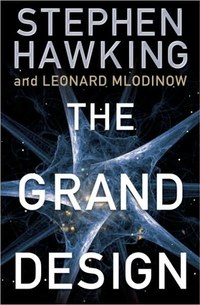Review: The Grand Designby Jeff Foust
|
| M-theory can explain why the universe seems fine-tuned to permit our existence: it’s just one of many universes in a multiverse, each with its own laws of physics. |
Much of The Grand Design is an overview of the unintuitive nature—as compared to our everyday experience—of quantum mechanics. This discussion, ranging from wave-particle duality to Feynman diagrams and quantum electrodynamics,eventually leads to something called M-theory. (The M in “M-theory” doesn’t necessarily stand for anything universally accepted; Hawking and Mlodinow suggest “master”, “miracle”, or “mystery”, as they claim the theory seems to embody all three attributes.) M-theory is a combination of several existing string theories (which treat particles as patterns of one-dimensional vibrations) where spacetime has 11 dimensions, seven of which are “curled up”.
Why would any of this be anything more than an intellectual curiosity, at least outside of the theoretical physics community? They go to explain that there are different ways to roll up these extra dimensions in M-theory, resulting in different apparent laws of nature. How many different ways? As many as 10500, or a 1 followed by 500 zeros. Each of these would result in a different universe with different physical laws, some more hospitable to the formation of stars, planets, and life than others. That can explain why the universe seems fine-tuned to permit our existence: it’s just one of many universes in a multiverse, each with its own laws of physics.
That’s a tough concept to try and get one’s mind around, but Hawking and Mlodinow try to make it easy (or at least less difficult) to understand through the liberal use of full-color illustrations as well as informal, even humorous language, as in this discussion of symmetry: “if you flip a donut over, it looks exactly the same (unless it has a chocolate topping, in which case it is better just to eat it.)” This high-level discussion will leave people who want to dig deeper into some of the book’s topics—such as why rolling up those additional dimensions in different ways results in different laws of physics—wanting, though.
The central message, though, of The Grand Design is the ultimate extension of the work of physicists and astronomers over the last several centuries, who have changed our view of the universe from one centered on the Earth to one where we are just one planet orbiting one of hundreds of billions stars in one of hundreds of billions of galaxies in our universe. Now, Hawking and Mlodinow argue, all of this is in just one of a vast number of universes. In other words, we’re nothing special at all. “[T]he multiverse concept can explain the fine-tuning of physical law without the need for a benevolent creator who made the universe for our benefit,” they write near the end of the book. That’s a change from A Brief History of Time, where Hawking writes at the end that with the creation of a “theory of everything” in physics, “we would know the mind of God.” The M-theory described in The Grand Design is a candidate for that theory of everything, but in the authors’ opinion that is a triumph of human thought, and not a link to a supreme being.
